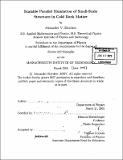Scalable parallel simulation of small-scale structures in cold dark matter
Author(s)
Shirokov, Alexander V. (Alexander Victorovich)
DownloadFull printable version (44.36Mb)
Other Contributors
Massachusetts Institute of Technology. Dept. of Physics.
Advisor
Edmund Bertschinger.
Terms of use
Metadata
Show full item recordAbstract
We present a parallel implementation of the particle-particle/particle-mesh (P³M) algorithm for distributed memory clusters. The llp3m-hc code uses a hybrid method for both computation and domain decomposition. Long-range forces are computed using a Fourier transform gravity solver on a regular mesh; the mesh is distributed across parallel processes using a static one-dimensional slab domain decomposition. Short-range forces are computed by direct summation of close pairs; particles are distributed using a dynamic domain decomposition based on a space-filling Hilbert curve. A nearly-optimal method was devised to dynamically repartition the particle distribution so as to maintain load balance even for extremely inhomogeneous mass distributions. Tests using 800³ simulations on a 40-processor Beowulf cluster showed good load balance and scalability up to 80 processes. We discuss the limits on scalability imposed by communication and extreme clustering and suggest how they may be removed by extending our algorithm to include a new adaptive P³M technique, which we then introduce and present as a new llap3m-hc code. We optimize free parameters of adaptive P³M to minimize force errors and the timing required to compute short range forces. We apply our codes to simulate small scale structure of the universe at redshift z > 50. We observe and analyze the formation of caustics in the structure and compare it with the predictions of semi-analytic models of structure formation. The current limits on neutralino detection experiments assume a Maxwell-Boltzmann velocity distribution and smooth spatial distribution of dark matter. (cont.) It is shown in this thesis that inhomogeneous distribution of dark matter on small scales significantly changes the predicted event rates in direct detection dark matter experiments. The effect of spatial inhomogeneity weakens the upper limits on neutralino cross section produced in the Cryogenic Dark Matter Search Experiment.
Description
Thesis (Ph. D.)--Massachusetts Institute of Technology, Dept. of Physics, 2005. Includes bibliographical references (p. 179-181).
Date issued
2005Department
Massachusetts Institute of Technology. Department of PhysicsPublisher
Massachusetts Institute of Technology
Keywords
Physics.